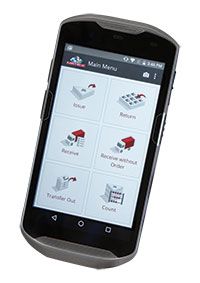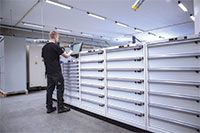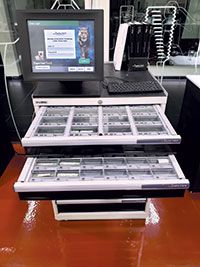by Kip Hanson
Making the case for integrated tool vending solutions in small to medium-sized businesses
Let’s face it. A lot of shops don’t even have a tool crib. And if there is a crib, chances are good that it’s unattended, functioning much like the box of Honor Snacks in the break room. You know how well that works. Still, unless it’s the shop owner’s old Uncle Fred, who retired ten years ago and has way too much time on his hands, it’s tough to justify the expense of a full-time employee to check tools in and out all day, let alone three people for those shops that work around the clock.
Corralling the chaos
So what’s the solution? How do you eliminate the insert hoarding, the all-too-frequent stock-outs, and the extremely painful and downright dumb machine stoppage that comes after? Cole Nedzlek knows a way. A project engineer for Walter USA LLC, he says one of the best ways to gain control over critical shop floor assets is by installing a tool dispensing system, and then encouraging workers to embrace it as an extension of their own toolbox.
 Skeptical? Granted, it’s going to take some effort to implement, but you can be sure it will be far more efficient than the, “hey, where’d you put the pack of 80-degree diamonds” chaos that exists in far too many shops. They’re also much easier to use than one might expect.
Skeptical? Granted, it’s going to take some effort to implement, but you can be sure it will be far more efficient than the, “hey, where’d you put the pack of 80-degree diamonds” chaos that exists in far too many shops. They’re also much easier to use than one might expect.
“For the most part, they’re web-based,” says Nedzlek. “Every fifteen minutes, the vending machine uploads all the transactions to the internet. You can log on, download a usage report from a web page and order the tools yourself, or set up min/max stocking levels and let your distributor take care of everything. It’s entirely up to you.”
Walter USA and indeed the majority of cutting tool suppliers and distributors offer some sort of tool vending solution. Systems are available for purchase, lease or possibly even free, depending on how many tools you buy each year and how good you are at arm-wrestling your tooling distributor. Each has its own unique operating parameters and capabilities (although they all work in a similar manner), its own set of pros and cons, but most are available in one or more of the following configurations:
 Open a drawer: With drawer-style tool dispensers, grabbing a tool is little different than grabbing one from the Lista cabinets you probably already own. The only difference is the computer monitor and probably a barcode reader sitting on top. Access to individual drawers or individual sections within each drawer is possible. Drawer-style dispensers are most suitable for inserts, shims, screws, and stick tools, but take a look at your Listas—whatever is currently being stored there can easily be transferred to a controlled vending system.
Open a drawer: With drawer-style tool dispensers, grabbing a tool is little different than grabbing one from the Lista cabinets you probably already own. The only difference is the computer monitor and probably a barcode reader sitting on top. Access to individual drawers or individual sections within each drawer is possible. Drawer-style dispensers are most suitable for inserts, shims, screws, and stick tools, but take a look at your Listas—whatever is currently being stored there can easily be transferred to a controlled vending system.
Ride the carousel: If you’re lucky enough to have one of those spinning appliance garages in the corner of your kitchen cabinets, you already have a good idea how carousel-style tool dispensers work. Make that appliance garage a meter taller, place a series of adjustable compartments throughout its interior, stick a computer-controlled door on the front, and voila, you have a tool dispenser ideal for the stuff that doesn’t fit in a drawer.
Grab a snack: Unlike the soda machines and candy dispensers that refuse to take your wrinkled bills, coil-equipped “snack-style” vending machines are a no-fail way to control faster moving tooling and supplies. Everything from packs of indexable inserts and pre-packaged drills and end mills to ear plugs, rubber gloves, and small abrasive wheels can be dispensed. And the good news? There’s no need to bang on the side of the cabinet because your potato chips get stuck.
Don’t kick the lockers: Remember that time you lost the big game and the coach yelled at you for kicking the gym locker? You probably don’t want to repeat that performance with a locker-style tool dispenser unless you like facing the supervisor’s even more unpleasant wrath. Whatever the case, this is likely where you’ll stick your vises and fixtures, angle plates, speeder heads, and any other largish tooling that’s too valuable or mission-critical to leave lying around. It’s also a great place for supplies such as those big cans of WD-40.
 Other styles and configurations exist, but this covers the lion’s share of what’s available. All require the operator to scan a badge or enter an employee number. He or she might then have to inform the system what job operation they’re working on, what tool they’re after and how many are needed, what department should be charged or answer whatever other questions have been programmed into the software. It’s also possible to define virtual locations within the software—the right-hand side of shelf 5 on rack 3 in the tool crib, for example.
Other styles and configurations exist, but this covers the lion’s share of what’s available. All require the operator to scan a badge or enter an employee number. He or she might then have to inform the system what job operation they’re working on, what tool they’re after and how many are needed, what department should be charged or answer whatever other questions have been programmed into the software. It’s also possible to define virtual locations within the software—the right-hand side of shelf 5 on rack 3 in the tool crib, for example.
Exploring the benefits
However you go about it, CTMS systems implementation specialist for the IMC member companies Tim Marlatt will tell you one thing: go for it. “We’re definitely seeing more interest, even in the smaller job shops with a handful of CNC machines,” he says. “We’ve recently expanded our line with these shops in mind, and customers are finding that, by implementing even one or two smaller dispensing cabinets, it gives them a much better grip on their more expensive tooling such as PCD and CBN inserts, indexable drill heads or the tools they tend to run out of more frequently. And for shops that run multiple shifts, it gives the purchasing people and production managers a better idea what happened after hours.”
For the more adventurous and technically minded, tool vending systems can be integrated into the shop’s ERP system. Slicing and dicing the now visible usage data is not difficult and provides an excellent view of possible waste and continuous improvement opportunities. Used cutting tools can more easily be controlled, and by entering the number of parts that were made between check-out and return, these often expensive assets are better managed. And again, the tool crib attendant can tasked with something more interesting.
Magnus Tillman, SecoPoint program manager at Seco Tools LLC, agrees. “Once you talk to a customer about the benefits, they’re pretty much convinced. Think about it—one stockout of a critical cutting tool is all it takes to incur hefty expedite fees and hours or even days of machine downtime. There’s no more worry about people wandering around looking for stuff; instead, your workshop will be fully utilized with green lights on your CNC machines. You’ll also have a much better idea of what tools are used most, which in turn gives you greater buying power. Ten years ago, the shops and distributors adopting tool vending were in the minority. Today, it’s a must for anyone that wants to stay competitive.” SMT
